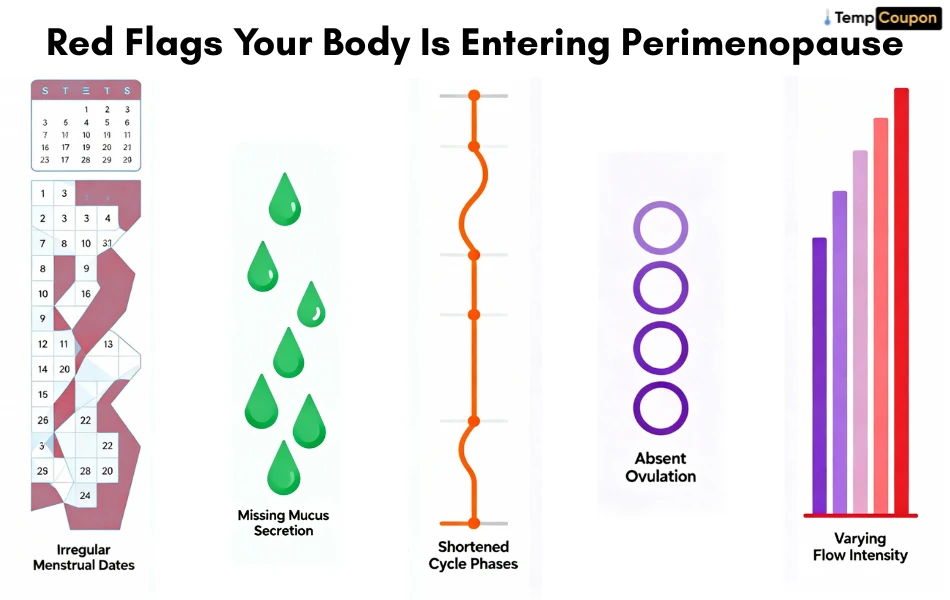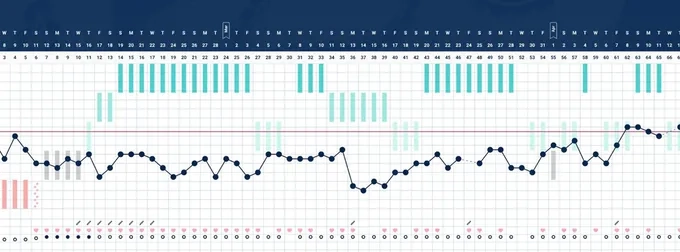Your Cycle Just Went Rogue? Perimenopause Symptoms Explained

Cycles that used to run like clockwork suddenly skipping months. Periods showing up at random. Temperatures fluctuating for no apparent reason. Sound familiar? This isn't your body malfunctioning—it's perimenopause announcing its arrival.
Most people hit perimenopause somewhere around their 40s, with full menopause typically arriving near age 50.
But here's the twist: your body starts dropping hints years before you realize what's happening.
5 Cycle Changes That Signal Perimenopause Has Started

🎲 Unpredictable Periods
Cycles that were once 28-30 days might suddenly shrink to 24 days or stretch to 35+ days. Some months you'll skip entirely. This happens because estrogen and FSH levels are bouncing around like a pinball machine, making ovulation completely unpredictable.
🚨 Vanishing Cervical Mucus
Your cervix becomes less responsive to hormonal signals. That fertile-quality mucus you used to track? It starts appearing less frequently or disappears altogether—a major sign your body is transitioning toward infertility.
✂️ Shortened Luteal Phase
The time between ovulation and your period (luteal phase) gets shorter. Instead of the typical 12-14 days, you might see just 8-10 days. This compression indicates declining progesterone production.
🌀 Anovulatory Cycles
Some months your body simply doesn't release an egg. No ovulation = no temperature spike = confused tracking apps. These anovulatory cycles become more frequent as perimenopause progresses.
🚩 Wild Bleeding Patterns
Heavier flows. Lighter spotting. Gushing episodes. Barely-there periods. Hormonal chaos creates unpredictable bleeding that can swing wildly from cycle to cycle.
Why Temperature Tracking Becomes Your Secret Weapon
Basal body temperature monitoring transforms from helpful to essential during perimenopause.
Your BBT reveals exactly when (or if) ovulation happens—information you can't get from period-tracking alone.
What Your Temps Reveal:
→ No temperature spike = no ovulation that cycle
→ High temps lasting <10 days = luteal phase deficiency
→ Erratic patterns = hormone fluctuations in real-time
→ Stable patterns returning = temporary fertility restoration

Tools like Tempdrop eliminate the hassle of remembering morning measurements. The sensor tracks continuously while you sleep, capturing accurate data even when your schedule gets chaotic.
🏷️ Pro tip: Use code FRIEND-LZBF3H9 at checkout for an additional 10% off
The Symptoms Nobody Warns You About
Hot flashes and night sweats get all the attention, but perimenopause brings sneaky symptoms that often go unrecognized:

These happen because estrogen receptors exist throughout your entire body—brain, heart, joints, bladder, skin. When estrogen levels drop, every system feels the impact.
Tracking Through the Chaos: Your Game Plan

Apply Postpartum Principles
Treat perimenopause tracking like postpartum charting. Expect irregular patterns, long cycles, and unpredictable fertile signs. The same fertility awareness methods work—you just need patience.
Use Symptothermal Method
Combine cervical mucus observations with temperature tracking. This dual-biomarker approach gives the clearest picture when cycles get erratic.
Work With a Certified Educator
If avoiding pregnancy matters, get professional guidance. A fertility awareness educator experienced in perimenopause can interpret confusing patterns and prevent mishaps.
Track Consistently
Measure temps at least 5 days weekly. Consistent data helps identify patterns even during irregular cycles. Missing measurements creates information gaps that make interpretation harder.
The Fertility Reality Check ✅
Perimenopause doesn't equal infertility—at least not immediately. Ovulation becomes sporadic, but pregnancy remains possible until you've gone 12 consecutive months without a period.
People hoping to conceive can optimize timing by tracking exactly when ovulation occurs. Those avoiding pregnancy need continuous vigilance since fertile windows become impossible to predict by calendar dates alone.
Why This Stage Deserves Your Attention
Tracking through perimenopause provides information your doctor can't get from a single blood test. Hormone levels fluctuate dramatically day-to-day, making snapshot lab work unreliable.
Your daily biomarkers—temperature shifts, mucus patterns, bleeding characteristics—create a comprehensive picture of what's actually happening inside your body. This data helps optimize conception attempts, prevent unplanned pregnancies, and understand symptom patterns.
Perimenopause lasts anywhere from 4-8 years on average. That's potentially a decade of reproductive changes happening in real-time. Understanding your patterns means controlling the narrative instead of feeling blindsided by your body's transformation.
The bottom line: Your cycle going haywire isn't random chaos—it's a predictable biological transition. Temperature tracking gives you the decoder ring to make sense of it all.


